ISSN ONLINE(2278-8875) PRINT (2320-3765)
ISSN ONLINE(2278-8875) PRINT (2320-3765)
D Mahesh1, M Arun Noyal Doss2, A Nithyanand3, C Naveen Kumar4
|
| Related article at Pubmed, Scholar Google |
Visit for more related articles at International Journal of Advanced Research in Electrical, Electronics and Instrumentation Engineering
A Various technique is available in reducing the cogging torque in Brushless DC machine (BLDC). Cogging torque is the main hindrance in BLDC motor, which results in direct impact on the performance of the Permanent Magnet (PM) motor. In this paper the PMs has various structures such as surface mounted, interior and buried permanent magnet. The cogging torque is compared for the various designs of the rotor structures. The CAD package validates the design and shows the performance enhancement of BLDC motor.
Keywords |
| BLDC motor, surface mounted, interior, buried magnet type |
INTRODUCTION |
| BLDC motor is a electronically commutated motor has been widely employed in industrial drive application for high performance, speed and position control systems. Also BLDC motor is used in blowers for ventilation systems and home appliances because of their high efficiency and cost effectiveness. The BLDC motor will have a major impact on cogging torque. The cogging torque is nothing but the interaction between the stator and rotor components. Whenever the rotor magnets crosses the stator slots a varying no current torque is produced which is called as cogging torque[1]- [8]. The appearance of no current torque will leads to vibration and acoustic noise. Hence the motor speed will gets reduced. |
| There are different methods adopted for reduction of cogging torque by varying the shapes and size of the stator and rotor in BLDC motor. Some of the effective techniques used for reduction of cogging torque are Stator slot –pole number, magnet pole arc design, auxiliary slots, magnet displacement, skewing of stator or rotor magnets, step skewing of the magnets, dummy slots, PM shifting. Hence by adapting these techniques the cogging torque can be reduced to a maximum level , but it cannot be completely eliminated[9]-[14]. |
| In this paper the T-shaped bi-furcated stator slots is made on the stator and different rotor structures such as surface mounted symmetrical, surface mounted asymmetrical, interior, buried permanent magnet type are designed . The simulation results are obtained by using finite element analysis. The cogging torque is analysed for the different structures and the low cogging torque, effective structure is found. |
DETERMINATION OF COGGING TORQUE IN BLDC MOTOR |
| The cogging torque is nothing but the interaction between the stator and rotor components. It is the energy variation in motor when there is no current in the windings. The cogging torque of the motor is defined as the rate of change of magneto static energy with respect to the rotation angle. |
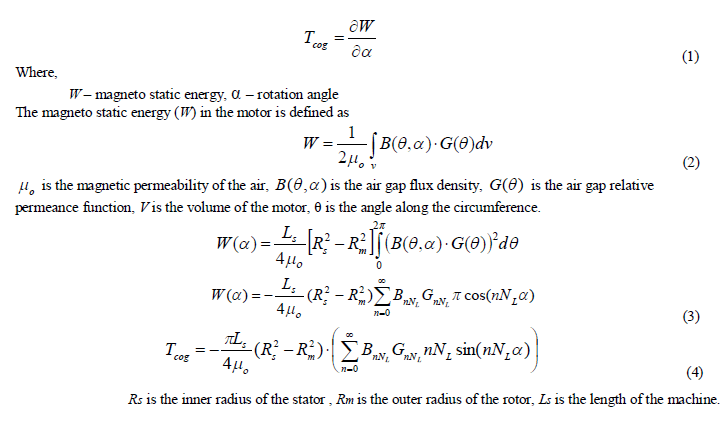 |
COGGING TORQUE REDUCTION METHODS |
| In this paper the cogging torque reduction methods is applied of the rotor only. The different types of methods used for minimizing the cogging torque are surface mounted symmetrical, surface mounted asymmetrical, interior ,buried type permanent magnet motors. The position of permanent magnets varies for the different methods[14]-[18].The use of permanent magnets on the BLDC machine have advantages such as, |
| 1. Simpler in construction and maintenance, |
| 2. Better dynamic performance than motors with electromagnetic excitation, |
Buried permanent magnet type |
| In Buried Permanent magnet type consists of 8 magnet poles on the rotor and 30 T-shaped bi-furcated stator slots on the rotor. Here the location of permanent magnet is buried radial type placed below the surface of the rotor. The buried type permanent magnet type machine model is shown in figure 1 .without meshing shows the solid model of buried type model, with meshing indicates the errorless model. |
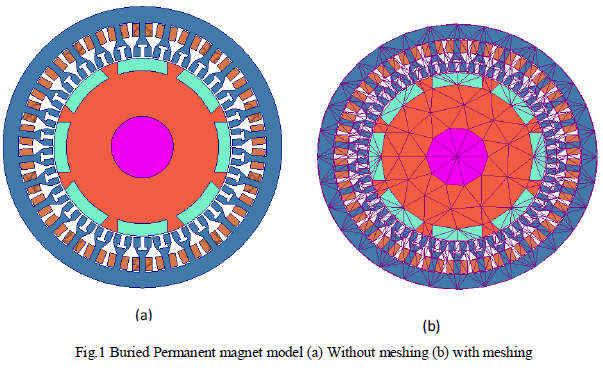 |
Interior permanent magnet type |
| In Interior Permanent magnet type consists of 8 magnet poles on the rotor and 30 T-shaped bi-furcated stator slots on the rotor. Here the location of permanent magnet is buried tangential type placed inside the rotor. The interior permanent magnet type machine model is shown in figure 2 .without meshing shows the solid model of interior type model, with meshing indicates the errorless model. |
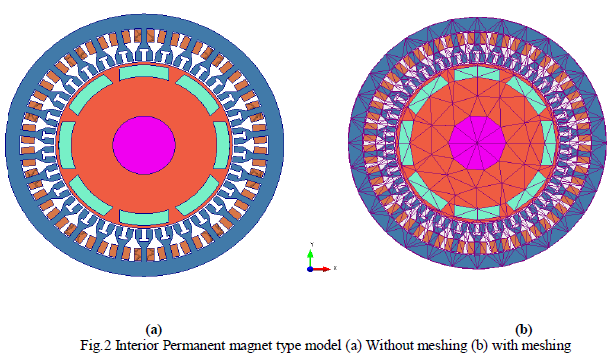 |
Surface mounted symmetrical |
| In Surface mounted symmetrical type consists of 8 symmetrical poles on the rotor and 30 T-shaped Bifurcated stator slots on the rotor. Here the location of permanent magnet is placed on the surface of the rotor. The Surface mounted asymmetrical type machine model is shown in figure 3 .without meshing shows the solid model of surface mounted asymmetrical type model, with meshing indicates the errorless model. |
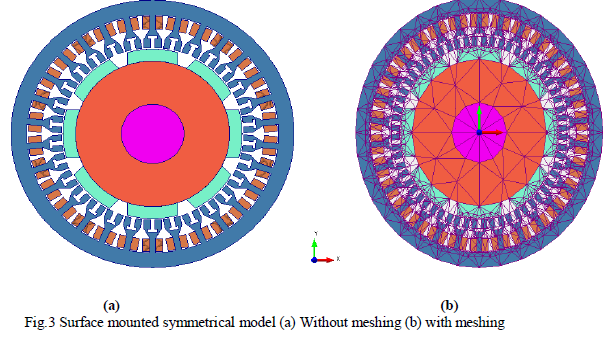 |
Surface mounted Asymmetrical |
| In Surface mounted asymmetrical type consists of 8 asymmetrical poles on the rotor and 30 T-shaped bifurcated stator slots on the rotor. Here the location of permanent magnet ias placed on the surface of the rotor. The Surface mounted symmetrical permanent magnet type machine model is shown in figure 4 .without meshing shows the solid model of surface mounted symmetrical type, with meshing indicates the errorless model. |
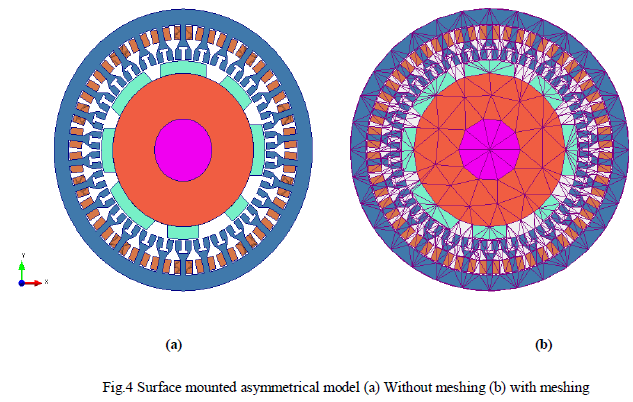 |
ANALYSIS OF RESULTS |
| The cogging is an important parameter which will affect the performance of the BLDC motor. Moreover the cogging torque in any BLDC machine model cannot be eliminated completely but can be greatly reduced by designing the stator and rotor. The reduced cogging torque values in different models is shown in table.1 |
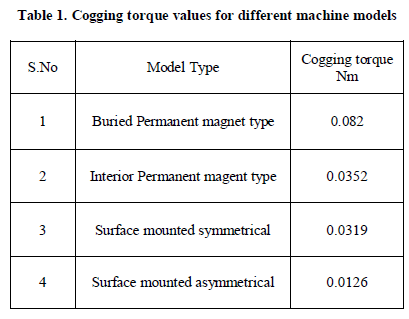 |
CONCLUSION |
| In this paper the cogging torque in BLDC motor is analysed by proposing the stator slot and adapting the different rotor types. The cogging torque BLDC motor varies according to the different rotor types.The cogging torque in surface mounted asymmetrical model is found to be the minimum when compared to the surface mounted symmetrical, interior type, buried type models. The cogging torque cannot be eliminated in any of these models but it can be reduced greatly by modifying the shape of poles. |
References |
|